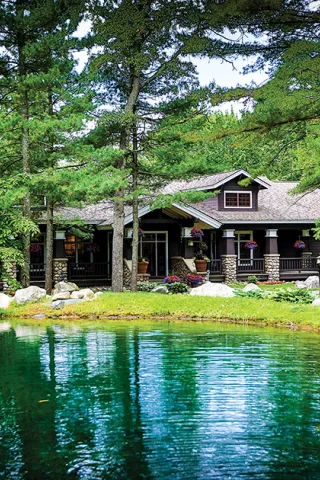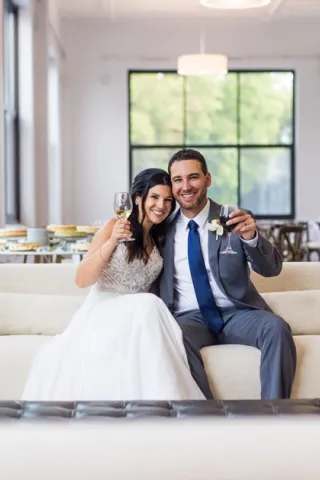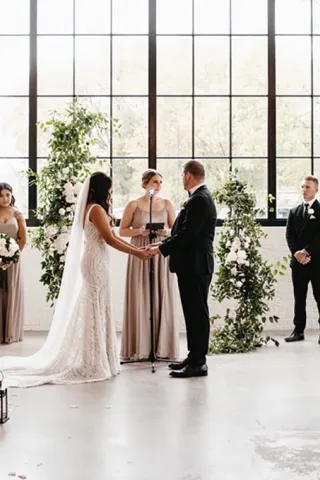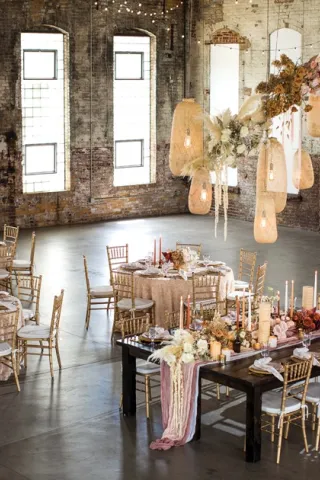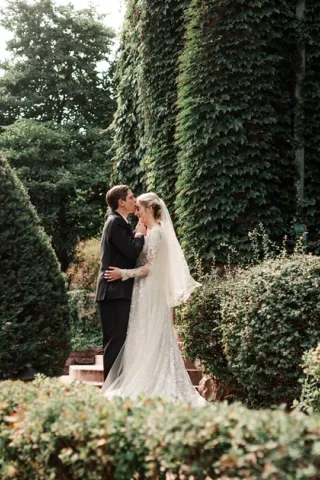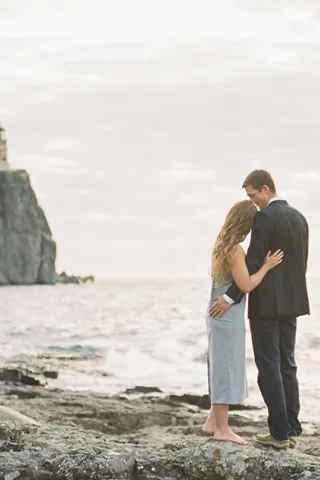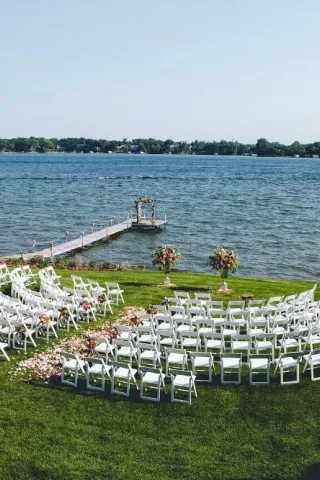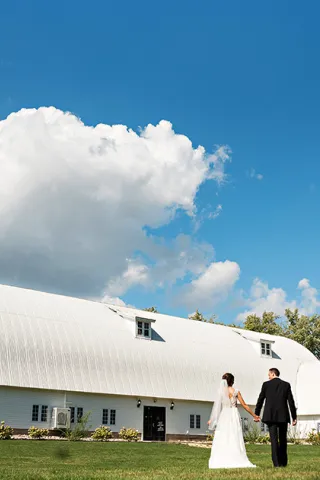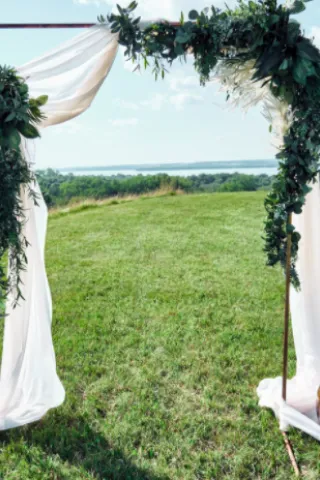It was a cloudy afternoon as Sarah Honsvall prepared to marry Patrick Rosemas in an outdoor ceremony at Stone Hill Ridge Golf Course in Stillwater. By the time the ceremony was underway, however, the clouds broke and the sun shone as she said “I do” under a tulle-draped canopy overlooking the lush greens. “It was perfect timing,” she recalls.
Rosemas had what many Minnesota brides dream of: the perfect outdoor wedding. With so many gorgeous sites to be found in Minnesota, it’s no surprise that countless couples head to the great outdoors to start their married life together.
Rachelle Mazumdar, director of weddings and events at Style-Architects in Minneapolis, emphasizes the unique and romantic feel that outdoor venues can add. “Outdoor spaces can offer an intimate experience for the bride and groom as well as the wedding guests,” she says.
But as many Minnesota natives can testify, our unpredictable climate can make the bravest bride wary of outdoor nuptials. “There are many weather extremes to consider,” says KSTP Channel 5 meteorologist Jonathan Yuhas. “But with appropriate planning, weather shouldn’t discourage couples from having a great outdoor wedding in Minnesota.”

Location, Location, Location
With lakes and prairies, parks and groves, wineries and apple orchards, the options for outdoor weddings in the North Star state are endless.
Recent bride Valerie Scott and her husband Jake chose to have their intimate ceremony and reception in a friend’s backyard in her hometown of Duluth. The location was particularly special to them, since it was where they met. “The area was surrounded by woods, a view of the lake and a gazebo that provided a picturesque, whimsical setting,” Scott recalls.
Ashley Friendshuh and her husband Eddie hosted their wedding at Minnetonka Orchards, which allowed them ample space for their large guest list. “Minnetonka Orchards has stunning views, a beautiful ceremony site and plenty of space for the kids to just run around and be kids,” Friendshuh notes. “We also incorporated fun activities such as a bonfire, wagon rides, a petting zoo and yard games.”
So where is the best place to host your big event?
“The first step to planning your outdoor wedding is to find a venue that you love and to make sure it fits your vision for the day,” says Sarah Trotter, owner of Lasting Impressions Wedding and Event Coordination in Minnetonka. The next step is to make sure that you can set up an appropriate shelter, if isn’t already available. “A tent or other form of shelter is an absolute must in Minnesota,” she says. Having a plan B is a necessity.
In fact, some wedding venues offer both indoor and outdoor options, eliminating the need for your own complicated back-up plans. Many venues even allow couples to use their reception site for the ceremony in case of inclement weather.
That was the case for Rosemas at Stone Ridge Golf Club. “The venue had such a great setup,” she says. “Since we had both an indoor banquet room and a covered tent, there was no way the weather could disturb our plans.”
Setting the Stage
With outdoor weddings, nature offers a backdrop that just can’t be beat. Rosemas used her picturesque setting as inspiration for her wedding décor, even designing a vintage floral-inspired invitation suite to go with the outdoor theme. Scott also drew from the natural beauty of the area to design her backyard wedding, keeping it simple, with big tents, wooden benches and string lights. “It felt romantic, enchanted and intimate,” she recalls.

Providing the Necessities
But while Mother Nature created stunning lakes, magical forests and to-die-for sunsets, she didn’t create portable toilets and parking lots. “There are a lot of extras to consider,” says Trotter, “but with enough planning it can be pulled off and be very beautiful.”
One of the main elements to consider is electricity, Mazumdar points out. “Be sure you understand the electricity available to you and its distribution,” she advises. Remember that all of your vendors may require power sources, often at the same time.
Lighting is another important feature, and couples should consider when the sun sets on the day of their wedding. “The daylight hours begin to change as the summer goes on,” Yuhas says. “Schedule your ceremony and reception so that you will have adequate lighting, whether natural or artificial.” As a bonus, lighting can provide a beautiful way to decorate your outdoor space. Rosemas used a variety of pieces, including candelabras, glass votives, café lights strung in the trees and a chandelier. “I wanted the space to feel warm and well-lit,” she recalls.
Another big factor: proper amplification for noisy outdoor settings. “Guests want to hear the ceremony and vows,” Mazumdar says. “Make it easier on them and rent the proper equipment.”
Most important, make sure your guests are comfortable. “Let them know in advance what to expect, so they can plan accordingly,” Trotter says. “They’ll appreciate knowing whether they should bring extra layers or avoid wearing high-heeled shoes.”
Favors can also help out, with weather-related options for those guests who might have come unprepared. Consider stylish shawls or umbrellas for a rainy or cold day, or bring festive fans for a potentially steamy day.
Uninvited Guests
The mosquito is the unofficial state bird of Minnesota, so prepare for them, along with a host of other critters. “Bugs are often the most unexpected and overlooked element,” Trotter notes. “I’ve seen everything from bees to mosquitoes to ants getting into the food.”
With the proper planning, you can keep bugs off the guest list. “Become familiar with your space. Get to know the area and what may be living in it,” recommends Trotter. Then check with your venue about ways to avoid having a bug issue. Often it’s as simple as providing bug spray for your guests. Some venues will also allow fogging before the ceremony to keep the bugs at bay while couples are saying their vows.
It All Adds Up
Outdoor wedding costs vary widely depending on the venue and how many extra items you need to bring in. The total cost for a space that’s equipped for outdoor weddings may be more reasonable than if you have to bring everything into the space. Hiring a planner will help you sort out all the additional needs for your space, which may even save you money in the long run.
Bottom Line
While an outdoor wedding may require a little more legwork, it can be well worth the effort. “Outdoor weddings allow couples to share their love for local spots with their friends and family,” Mazumdar says. “Whether it is a family backyard, a botanical garden or a rustic barn, the couple can choose a space that reflects their shared interests and vision for the day.”
The key to outdoor wedding success is to relax and enjoy the day, says Scott. “You can’t control the weather, but you can control whether or not you choose to have a good time,” she says. “Choose to enjoy this day.”
![]()
Planning for the Weather
In Minnesota, weather means a lot more than just rain. Meteorologist Jonathan Yuhas of KSTP Channel 5 News has been in the weather business for almost 20 years. Here are his tips for couples who want to take their nuptials outdoors.
• The safest outdoor wedding season in Minnesota is from late May to late September. Yuhas’ first choice for an outdoor wedding in Minnesota: July. “It’s never a guarantee,” he says. “But it tends to be the most dependable month weather-wise.”
• If you’re having a wedding in April or May, remember that it can still snow at this time of year.
• Summer rain is typically shorter and more isolated than fall rain, which can last all day.
• Don’t underestimate humidity. August can be especially humid, so plan accordingly to keep you and your guests comfortable.
• Mosquitoes typically make their first appearance in June and peak in August, and are worse around lakes or bodies of water. Cicadas will become loud around August, so be sure to have good amplification in areas where you may encounter them.
• Keep in mind when the sun will set. In October, for example, the days start growing shorter, so plan your ceremony time earlier.
• The lightest winds generally occur the first two weeks of August.
• Remember that weather in Minnesota is never predictable. Be prepared for all circumstances to ensure a flawless day.
Want a personal weather consultant for your wedding? FlashWarn, a Minneapolis-based weather consulting company, offers a wide range of weather forecasting information. For information, contact Jonathan Yuhas at FlashWarn, [email protected], 612.483.8063.
![]()
The Outdoor Wedding Checklist
A list of essentials to ensure that your festivities go off without a hitch.
• Shelter The most critical element! Don’t test Mother Nature on this one. Tent rentals are a great option, and be sure to rent one that has side walls that can be lowered in case of rain or heavy wind.
• Tables, chairs, linens and dishes If your venue does not provide these, they can be rented. Save money by checking with your caterer to see if they provide these items as part of your package.
• Insect control Mosquitoes can be just the tip of the iceberg. Scope out your venue and talk to locals to understand how to deal with these wedding crashers.
• Electricity Be sure to consider all of your power needs, including lighting, heating or cooling, and anything that your vendors may need.
• Restrooms This often-overlooked necessity is a must for wedding-day success. A good rule of thumb is to have one bathroom or stall for every 50 guests, so they will spend less time standing in line and more time on the dance floor.
• Heating/cooling Don’t underestimate dramatic temperature changes, no matter what time of year.
• Transportation/parking Nontraditional locations may be remote and may not have standard parking lots. Ensure that your guests can find adequate parking, or hire a shuttle or valet service for them.
• Appropriate apparel Will your guests be hot or cold, or be traipsing through mud? Make sure they know what kind of environment they will find at your wedding venue. Fun tips: Provide shawls for the chilly nights, decorative fans for hot days, or fun party flip-flops for walking on wet grass.
• Permits Weddings at local parks may require a permit. Check with your park board to ensure that you have the proper paperwork.
• Garbage Often your caterer will provide garbage facilities, but be sure to check in advance.
• Noise Check with your local authorities on any precautions you should take to limit noise disturbances, particularly if you are hosting your wedding in a residential neighborhood.
